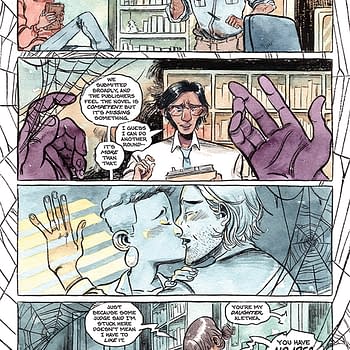Posted in: Comics | Tagged: avatar press, comicon, game of thrones, george r r martin, san diego, sdcc, The Skin Trade, william christensen
George R. R. Martin Blames Comics for his Success in TV/Film at SDCC
Hannah Means-Shannon writes for Bleeding Cool:
George R. R. Martin, introduced by William Christensen of Avatar Press on behalf of his upcoming series The Skin Trade, quickly jumped into discussing his own history as a comic book fan, first appearing in print in a fan letter to Stan Lee and Jack Kirby in the Fantastic Four. He also had plenty to say about the long history of comic cons, and his enthusiastic pursuit of them over the years.

Martin's Skin Trade novella is a Werewolf story, featuring a hypochondriac Werewolf, and the story in its original printing won the H. P. Lovecraft award. Because of the nature of the story, Martin always thought "there was great potential for it in the visual medium". It was optioned several times as a motion picture, and Martin has been seeking film adaptation for it for some time. We may well see Skin Trade: The Movie before too long. Christensen said the book has basically been "cursed" in looking for an artist, taking 9 years as artists came onto the book and as Martin said "ran away in horror". They finally secured the always overbooked Mike Wolfer, one of Martin's original first choices, for Skin Trade.

Christensen asked Martin about his background in horror writing, and whether he continues to return to the genre. Martin said his father called horror, fantasy, and adventure, "weird stuff" in one category, and he continues to see things the same way, having read them all interchangeably growing up. As a kid he called them "monster stories" and pursued them avidly. Kids these days, he said, may not consider Boris Karloff scary, but he did growing up. He picked up a collection of horror stories as a young person at college with Boris Karloff's face and name on the cover with an introduction by him. Inside was a story by "this guy" H.P. Lovecraft, that "scared the crap out of me", Martin said (The Watcher in the Darkness). He promptly went out and got every copy of Lovecraft stories he could find, which was difficult at the time in New Jersey in the days before Amazon. He discovered a hardcover of Lovecraft and brought it back to his dormroom. Describing it to his roommates, they thought that "Lovecraft" meant pornography and tried to snatch it from him.
Genre-mashing has always been appealing to Martin, and some of his most well-known stories jump right into the mix, including his first story every made into a feature film. "I like to mix things", he said. Martin was born in 1948, so when he first started reading comics in the mid 50's, he was reading Superman and Superboy, but also "kiddie" comics like Carl Barks. But alongside that he was reading sci-fi and fantasy comics that were mostly "lame". He had missed EC and so had "no knowledge of truly scary horror comics", since the "teeth had been pulled out" of the fantasy comic genre. He described the monster stories in Marvel publications as being "lame", and though he read them, he was disappointed not to be scared by them. At the barber shop, he found an EC comic once as a kid, and "my God that stuff was stronger stuff than what I was reading in Tales to Astonish". He tracked down what EC comics he could, since there weren't comic shops at the time, or a move of comic fandom he could be part of. He was "right there at the beginning" at the start of the Marvel Golden Age, but there was little horror-based to satisfy his mind.
Christensen pointed out that with all Martin's success, he keep coming back to support comics, and asked Martin what makes comics so special to him. "It's another way to tell stories", he said, "a fusion of the visual with words". One thing he's learned working on Game of Thrones is that different mediums have different needs. He can do things in prose, he said, that HBO despite their budget can't approach, like unreliable narrator and internal monologue. On the other hand, he said, his books can't have a soundtrack, or a director's eye to frame a shot. Comics, similarly, have their own ways of looking at the world and can do things that prose and film can't do. No shooting schedule, and not as much of a hard budget enable him to expand on some pages and go long if possible. Comics have changed a lot, Martin observed, from the early comics he collected, very conservative, he thinks, in their visual style with a fixed location for splash-page and grid layouts. Alan Moore, Martin said, is really a film director in a comic form, and so stretches the medium more fully.
Martin's easy familiarity with comics and his commitment to their strengths reveals that he's still a fanboy in many ways and that's simply not going to change. He sees it as a vehicle for some of his favorite subject matter, and thinks horror is still at home on the comics page, with even greater freedom perhaps than in his childhood. And as he continues to allow his works to be adapted into comics, we can look forward to more Martin adaptation into film, by all accounts. There's something about Martin's work that lends itself to visual media, not surprising given his obsession with comics from a young age. We may have the key there to the success of the mega HBO show Game of Thrones based on Martin's books- comics! Comics are to blame for great film and TV projects once again. Skin Trade is out now in shops. Fevre Dream at 10 issues is also out in collection.
Hannah Means-Shannon writes and blogs about comics for TRIP CITY and Sequart.org and is currently working on books about Neil Gaiman and Alan Moore for Sequart. She is @hannahmenzies on Twitter and hannahmenziesblog on WordPress. Find her bio here.














